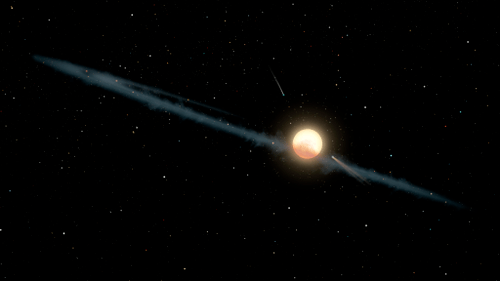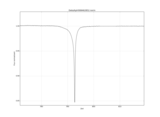Disrupted planet

"Disrupted planet" is an official astronomical term[1][2] for a planet, or exoplanet, that has been disrupted, or destroyed, by a nearby, or passing, astronomical body or object, such as a star.[1][2] The result of such a disruption may be the production of excessive amounts of related gas, dust and debris,[3] that may eventually surround the parent star in the form of a circumstellar disk or debris disk. As a consequence, the orbiting debris field may be an "uneven ring of dust", causing erratic light fluctuations in the apparent luminosity of the parent star, as may have been responsible for the oddly flickering light curves associated with the starlight observed from certain variable stars, such as that from KIC 8462852, RZ Piscium and WD 1145+017. Excessive amounts of infrared radiation may be detected from such stars,[4] suggestive evidence in itself that dust and debris may be orbiting the stars.[3][5][6][7]
Examples
Planets
Examples of planets (or their related remnants), considered to have been a disrupted planet, or part of such a planet, include: 'Oumuamua[8] and WD 1145+017 b, as well as asteroids,[9] hot Jupiters[10] and those that are hypothetical planets, like Fifth planet, Phaeton, Planet V and Theia.
Stars
Examples of parent stars, considered to have caused a planet to have been disrupted, include: EPIC 204278916, KIC 8462852 (Tabby's Star), PDS 110, RZ Piscium, WD 1145+017 and 47 Ursae Majoris.

Light curve gallery
KIC 8462852 (Tabby's Star)

 All light curve data −
All light curve data −
December 2009 to May 2013
scan days 0066 − 1587
(Kepler only) 5 March 2011 − day 792
5 March 2011 − day 792
15% max dip (Kepler) 28 February 2013 − day 1519
28 February 2013 − day 1519
22% max dip (Kepler) 17 April 2013 − day 1568
17 April 2013 − day 1568
8% max dip (Kepler)
See also
References
- 1 2 Staff (22 December 2017). "Young Star RZ Piscium is 'Eating' Its Own Planets, Astronomers Say". Sci-News.com. Retrieved 23 December 2017.
- 1 2 Fryling, Kevin (21 December 2017). "IU astronomer's analysis helps discover that a star in the constellation Pisces is a 'planet-eater'". Indiana University. Retrieved 23 December 2017.
- 1 2 Punzi, K. M.; Kastner, J. H.; Melis, C.; Zuckerman, B.; Pilachowski, C.; Gingerich, L.; Knapp, T. (21 December 2017). "Is the Young Star RZ Piscium Consuming Its Own (Planetary) Offspring?". The Astronomical Journal. 155 (1): 33. arXiv:1712.08962. Bibcode:2018AJ....155...33P. doi:10.3847/1538-3881/aa9524.
- ↑ Farihi, J.; Jura, M.; Zuckerman, B. (10 March 2009). "Infrared Signatures of Disrupted Minor Planets at White Dwarfs". The Astrophysical Journal. 694 (2): 805–819. arXiv:0901.0973. Bibcode:2009ApJ...694..805F. doi:10.1088/0004-637X/694/2/805.
- ↑ Landau, Elizabeth (4 October 2017). "Mysterious Dimming of Tabby's Star May Be Caused by Dust". NASA. Retrieved 23 December 2017.
- ↑ Meng, Huan Y.A.; et al. (3 October 2017). "Extinction and the Dimming of KIC 8462852". The Astrophysical Journal. 847 (2): 131. arXiv:1708.07556. Bibcode:2017ApJ...847..131M. doi:10.3847/1538-4357/aa899c. Retrieved 23 December 2017.
- ↑ Tabor, Abby (5 October 2017). "The scientific quest to explain Kepler's most enigmatic find". Phys.org. Retrieved 23 December 2017.
- ↑ Ćuk, Matija (2017). "1I/ʻOumuamua as a Tidal Disruption Fragment From a Binary Star System". The Astrophysical Journal. 852: L15. arXiv:1712.01823. Bibcode:2018ApJ...852L..15C. doi:10.3847/2041-8213/aaa3db.
- ↑ Soter, Steven (2006). "What is a Planet?". The Astronomical Journal. 132 (6): 2513. arXiv:astro-ph/0608359. Bibcode:2006AJ....132.2513S. doi:10.1086/508861.
- ↑ Nayakshin, Sergei (20 September 2011). "Hot Super Earths: disrupted young jupiters?". Monthly Notices of the Royal Astronomical Society. 416 (4): 2974–2980. arXiv:1103.1846. Bibcode:2011MNRAS.416.2974N. doi:10.1111/j.1365-2966.2011.19246.x. Retrieved 25 December 2017.
- ↑ Gary, Bruce L. (14 November 2017). "Hereford Arizona Observatory photometry observations of KIC 8462852". BruceGary.net. Retrieved 24 December 2017.
- ↑ Gary, Bruce L. (4 October 2017). "Hereford Arizona Observatory photometry observations of KIC 8462852 between 2 May and 4 October 2017". BruceGary.net. Archived from the original on 4 October 2017. Retrieved 23 December 2017.
"Note: g'-band and r'-band dip depths (and shapes) may differ, with g'-band being more sensitive to dust cloud scattering due to its shorter wavelength (0.47 vs. 0.62 micron). For a reasonable particle size distribution (e.g., Hanson, 0.2 micron) the extinction cross section ratio would produce a depth at r'-band that is 0.57 x depth at g'-band. If g'-band depth is 0.3 %, for example, depth at r'-band could be 0.17 %. The "Tabby Team" measurements (Fig. 3) at r'-band are compatible with that small dip depth. Incidentally, none of these shapes resemble exo-comet tail transits (as described by Rappaport et al, 2017 link); so the mystery of what's producing these week-timescale dips continues! Actually, long oval shapes are known to produce V-shaped dips (think of rings with a high inclination)." - bg - ↑ Gary, Bruce L. (1 January 2018). "Hereford Arizona Observatory photometry observations of KIC 8462852 between 2 May and 31 December 2017". BruceGary.net. Archived from the original on 1 January 2018. Retrieved 1 January 2018.
- ↑ Gary, Bruce L. (4 May 2018). "Hereford Arizona Observatory photometry observations of KIC 8462852 between 2 May 2017 and 4 May 2018". BruceGary.net. Archived from the original on 5 May 2018. Retrieved 5 May 2018.
External links
- NASA – WD 1145+017 b at The Extrasolar Planets Encyclopaedia.
- "Disrupted planet":
- Video (13:46) − "Tabby's Star" on YouTube, a presentation by Tabetha S. Boyajian.
- Video (31:00) − "Tabby's Star" on YouTube, a presentation by Issac Arthur.
- Video (01:00) − RZ Piscium on YouTube, star with unusual light fluctuations (21 December 2017).